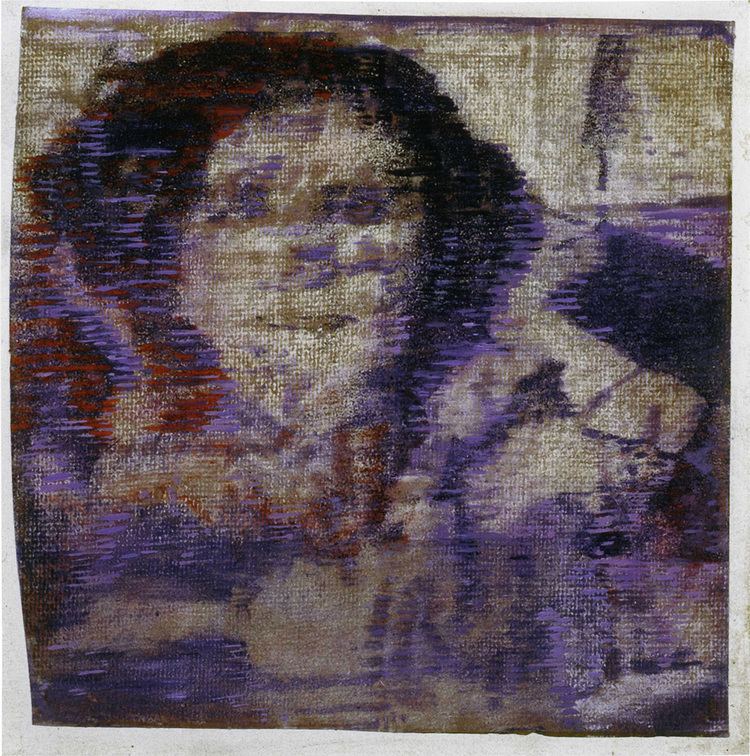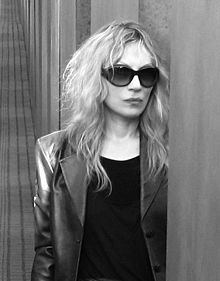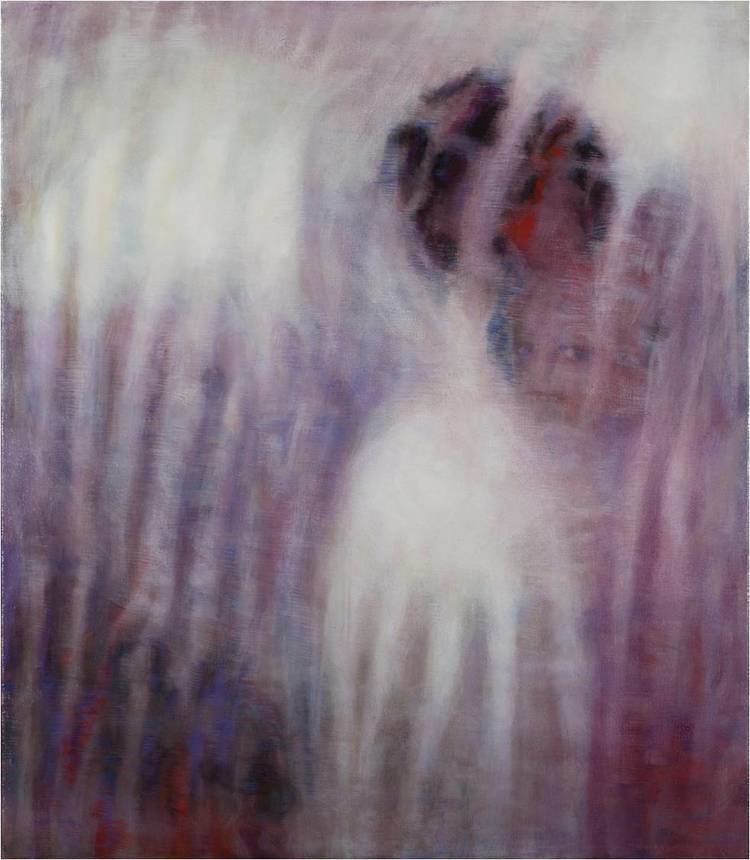Region Western Philosophy Period Contemporary art Role Visual Artist | Name Bracha Ettinger Children Lana Ettinger | |
 | ||
Main interests Psychoanalysis, art, feminist theory, aesthetics, human rights, ethics, the Maternal Notable ideas Matrixial gaze, matrixial trans-subjectivity Artwork Matrix - Family Album Series, Eurydice and Ophelia n.2 Education Hebrew University of Jerusalem, Paris 8 University Influenced by Sigmund Freud, Jacques Lacan, Emmanuel Levinas, Felix Guattari, Jean-Francois Lyotard, Francisco Varela Similar People Sigmund Freud, Jacques Lacan, Emmanuel Levinas, Felix Guattari, Jean‑Francois Lyotard | ||
Bracha l ettinger aesthetics proto ethics and maternal subjectivity 2010
Bracha Lichtenberg Ettinger (Hebrew: ברכה אטינגר, ברכה ליכטנברג-אטינגר) is an Israeli-born painter. As visual artist she has mainly produced paintings, drawings, notebooks and photography. She is also a philosopher, psychoanalyst and writer.
Contents
- Bracha l ettinger aesthetics proto ethics and maternal subjectivity 2010
- Bracha l ettinger lecture and painting
- Life and work
- Artist
- Group exhibitions
- Psychoanalyst
- Major concepts
- The early theory from 1985 through the 1990s
- The theory in the 2000s
- Other activities
- Fascinance Forum for Ettinger Studies
- Publications
- Recent selected publications
- Selected publications
- Conversations
- Lectures and seminars
- References

Ettinger's work consists mostly of oil painting. Ettinger is now considered to be a prominent figure among both the French painters' and the Israeli art's scenes. Ettinger's art was recently analysed at length in the book Women Artists at the Millennium, in Griselda Pollock's Encounters in the Virtual Feminist Museum and in Catherine de Zegher's anthology Women's Work is Never Done. Her ideas in cultural theory, psychoanalysis, and French feminism (see Feminist theory and psychoanalysis) achieved recognition after the publication of Matrix and Metramorphosis (1992), fragments from her notebooks (Moma, Oxford, 1993) and The Matrixial Gaze (1995). Over the last two decades her work has been influential in art history, film studies (including feminist film theory), psychoanalysis, aesthetics and gender studies.

Ettinger is a Professor at European Graduate School in Saas-Fee, Switzerland.

Bracha l ettinger lecture and painting
Life and work

Bracha Ettinger was born in Tel Aviv on 23 March 1948. She received her M.A. in Clinical Psychology from the Hebrew University of Jerusalem. She moved to London in 1975 and studied, trained and worked between 1975 and 1979 at the London Centre for Psychotherapy, the Tavistock Clinic and the Philadelphia Association with R. D. Laing. Her daughter the actress Lana Ettinger was born in London. She returned to Israel in 1979 and worked at Shalvata Hospital. Ettinger, who has painted and drawn since early childhood, is self-taught. In her early days she avoided the art scene. In 1981 she decided to become a professional artist and moved to Paris where she lived and worked from 1981 to 2003. Her son Itai was born in 1988. As well as painting, drawing and photography, she began writing, and received a D.E.A. in Psychoanalysis from the University Paris VII Diderot in 1987, and a Ph.D. in Aesthetics of Art from the University of Paris VIII in 1996.

Ettinger had a solo project at the Pompidou Centre in 1987, and a solo exhibition at the Museum of Calais in 1988. In 1995 she had a solo exhibition at the Israel Museum in Jerusalem, and in 1996 she participated in the Contemporary art section of Face à l'Histoire. 1933–1996 exhibition in the Pompidou Centre. In 2000 she had a mid-life retrospective at the Centre for Fine Arts (The Palais des Beaux Arts) in Brussels, and in 2001 a solo exhibition at the Drawing Center in New York. As well as working as an artist, Ettinger continued to train as psychoanalyst with Françoise Dolto, Piera Auglanier, Pierre Fedida, and Jacques-Alain Miller, and has become an influential contemporary French feminist. Around 1988 Ettinger began her Conversation and Photography project. Her personal art notebooks have become source for theoretical articulations, and her art has inspired art historians (among them the distinguished art historian Griselda Pollock and international curator Catherine de Zegher) and philosophers (like Jean-François Lyotard, Christine Buci-Glucksmann and Brian Massumi) who dedicated a number of essays to her painting.
Even though she was still based mainly in Paris, Ettinger was visiting professor (1997–1998) and then research professor (1999–2004) in psychoanalysis and aesthetics at the School of Fine Art, History of Art and Cultural Studies at the University of Leeds. Since 2001 she has also been visiting professor in Psychoanalysis and Aesthetics at the AHRC Centre for Cultural Analysis, Theory and History (now CentreCATH). Ettinger had partly returned to Israel in 2003, and has kept studios in both Paris and Tel Aviv ever since. She was a lecturer at the Bezalel Academy of Art and Design in Jerusalem until 2006. Some of her specific academic fields of endeavor are feminist psychoanalysis, art, aesthetics, ethics, the gaze, sexual difference and gender studies, Jacques Lacan, the feminine, early (including pre-birth) psychic impressions, pre-maternal and maternal subjectivity.
Artist
Ettinger's research concerns light and space, and in this it follows from Manet and Rothko. Her subjects concern the human condition and the tragedy of war, and her work in this aspect follows on after artists such as Käthe Kollwitz and Francisco Goya. The painting process engages a space of passage between figures and abstraction, and her attitude to abstraction resonates with the spiritual concerns of Agnes Martin and Hilma af Klint. Another major subject in her work is the unconscious and in particular the feminine and the maternal. Her notebooks accompany the painting process but are equally art works.
From 1981 until 1992, Ettinger's principal artwork consisted of drawing and mixed media on paper as well as notebooks and artist's books, where alongside thoughts and conversations, she made ink and wash painting and drawing. Since 1992, apart from her notebooks, most of her artwork consists of mixed media and oil paintings, with few parallel series that spread over time like: "Matrix — Family Album", "Autistwork" and "Eurydice", with themes of generational transmission of memory, personal and historical trauma, the Shoah and the World Wars, the gaze, light and the space, womanhood and maternality, inspired by classical painting and creating an abstract space where the questions of beauty and sublime become relevant for our time. Images that she obtains first by collage and xerox processing are abstracted in a long process of oil painting that takes a few years.
According to Griselda Pollock, Catherine de Zegher and Chris Dercon, director of the Tate Modern who had chosen her work for the contemporary art section of the Pompidou Center's major exhibition of 20th Century art Face à l'Histoire, Ettinger has become one of the major artists of the New European Painting. Along with painting she has worked on installations, theoretical research, lectures, video works, and "encounter events". Her paintings, photos, drawings, and notebooks have been exhibited at the Pompidou Centre (1987, 1996, 2010–2011), and the Stedelijk Museum in 1997. In the last decade, Ettinger's oil on canvas paintings involve figures like Medusa, Demeter and Persephone, and Eurydice. Though from 2010 onward her work still consists mainly of oil paintings and drawings, she is also doing new media animated video-films where the images are multi-layered like her painting. In 2015, Ettinger participated in the 14th Istanbul Biennial drafted and curated by Carolyn Christov-Bakargiev.
Group exhibitions
Among the venues Ettinger presented in:
Psychoanalyst
Ettinger is a theoretician who proposed an ontology of string-like subject-subject (trans-subjective) and subject-object (transjective) transmissivity for a rethinking of the human subject. Working at the intersections of human subjectivity, feminine sexuality, maternal subjectivity, psychoanalysis, art and aesthetics, she contributed to psychoanalysis the idea of a feminine-maternal sphere, function, and structure with its symbolic and imaginary dimensions based on femaleness in the real (womb). This dimension, as symbolic, contributes to ethical thinking about human responsibility to one another and to the world. She is a senior clinical psychologist, and a practising psychoanalyst. Her artistic practice and her articulation, since 1985, of what has become known as the matrixial theory of trans-subjectivity have transformed contemporary debates in contemporary art, psychoanalysis, women's studies, and cultural studies. Ettinger was an analysand of Ronald Laing in London and Piera Aulagnier in Paris. She is member of the Tel Aviv Institute for Contemporary Psychoanalysis (TAICP), the New Lacanian School (NLS) and the World Association of Psychoanalysis (AMP / WAP). For Ettinger, the Freudian attitude to psychoanalysis is crucial as it emphasizes the phantasmatic value of materials that arise during regression. To Freud and Lacan she adds, however, a feminine-maternal space-time with its particular structures, functions, and dynamics in the unconscious. She claims that, in a similar way, when seduction is assigned to the paternal figure during regression, it is recognized in most cases as a result of the therapeutic process itself. It is worked-through accordingly without therapist's father-blaming, and without a resulting father-hate. Therapists must likewise realize that during regression phantasmatic maternal "not-enoughness" appears and must also be recognized as the result of the process itself, and be worked-through without the mother-hating that Ettinger considers contributes to a "psychotization" of the subject, and a block to the passage from rage to sorrow and compassion. To be able to recognize the phantasmatic status of the psychic material arising during therapy, the Lacanian concepts of Symbolic, Imaginary and Real are useful to her.
The idea of a corpo-Real is a part of her symbolization of a new feminine psychic zone (the matrixial, the womb as time space of psychic encounter-event), in both male and female subjects, and of the feminine-matrixial sexual difference. Thus, even if Ettinger critiques the Freudian and Lacanian analysis of the feminine, she considers herself as a "post" or "neo" Freudian and Lacanian, who elaborates the feminine in continuity to these psychoanalysts, but claims a supplementary feminine-maternal Eros. Ettinger criticises Winnicott and Bollas for offering patients a "ready-made mother-monster" as a cause for each psychic pain. She considers any practice of archaic-motherhood blaming as an obstacle, as "hystericizing" and even momentarily "psychoticizing" (in the sense of leading to internal splits rather than recognition of differences,) when such "cause" is brought as "explanation" by the analyst, a "cause" attributed to the unremembered early period of life where I and non-I are transconnected. Ettinger agrees with Lacan that the "ultimate" cause is in principle lacking: objet a. She calls for a delicate process of differentiation, coemergence, and cofading between the generations, especially in analysing the same-sex (daughter-mother, son-father) relationships, with emphasize on transmission, not split. Thus, the process itself helps to negotiate and articulate delicately sexual difference, in the present. To the idea that the self is structured via mirror-like reflection she adds that of primal apperception of the other, through "fascinance" (aesthetic openness to the other and the cosmos), compassion and awe (affective accesses to the other) directed from the beginning to the (m)Other and the outside, not to the self.
Major concepts
Ettinger invented the Matrixial Trans-subjectivity theory, or simply "The Matrixial". Ettinger is a Freudian scholar and follows the late Jacques Lacan, Emmanuel Levinas, Object relations theory and Gilles Deleuze/Félix Guattari.
The early theory: from 1985 through the 1990s
Ettinger articulated a feminine-maternal (and feminine-prematernal) dimension, space, function, Eros and dynamics in the human Unconscious. She had suggested that pre-natal impressions, connected to the phantasmatic and traumatic real of the pregnant becoming-mother, are trans-inscribed in the emerging subject and form the primary phase and position of the human psyche. "I" and "non-I", without rejection and without symbiotic fusion, conjointly inscribe memory traces that are dispersed asymmetrically but in a trans-subjective mode. Trans-subjective mental and affective unconscious "strings", connecting the prenatal emerging subject to the archaic m/Other, open unconscious routes ("feminine", non phallic, in both males and females) that enable subjectivizing processes all throughout life whenever a new matrixial encounter-event takes place. The matrixial encounter-event forms specific aesthetical and ethical accesses to the Other. Ettinger articulated the 'matrixial gaze' and the process of 'co-poiesis'. This allows new understanding of trans-generational transmission, trauma and artistic processes. Ettinger formulates the woman(girl)-to-woman(mother) difference as the first sexual difference for females to be viewed first of all according to the matrixial parameters. The feminie-maternal Eros informs also the father/son and mother/son relations. According to Ettinger, in parallel but also before expressions of abjection (Julia Kristeva) or rejection (Freud on Narcissism) of the other, primary compassion, awe and fascinance (which are unconscious psychic affective accesses to the other, and which join reattunement and differentiating-in-jointness by borderlinking) occur. The combination of fascinance and primary compassion does not enter the economy of social exchange, attraction and rejection; it has particular forms of Eros and of resistance that can inspire the political sphere and reach action and speech that is ethical-political without entering any political institutional organization. The infant's primary compassion is a proto-ethical psychological means that joins the aesthetical fascinance and creates a feel-knowing that functions at best within maternal (and also parental) compassionate hospitality. Here, one witnesses in jointness: The I wit(h)ness while borderlinking (bordurelaint) to the non-I and borderspacing (bordurespacant) from the other. Ettinger calls for the recognition of the matrixial transference as a dimension in the transferential relationships in psychoanalysis. They must entails besideness to (and not a split from) the archaic the m/Other (Autremere) and parental figures; jointness-in-differentiation rather than their exclusion. She sees in the trans-subjectivity a distinct dimension of human specific linkage and shareability, different from, and supplementary to "inter-subjectivity" and "self" psychology. Her most prominent and comprehensive book regarding this theory is "The Matrixial Borderspace" (reprint of essays from 1994–1999) published in French in 1999 and in English in 2006, but her most recent concepts are mainly elaborated in the different essays printed in 2005–2006.
The theory in the 2000s
Her more recent artistic and theoretical work centers around the spiritual in art and ethics. In the domain of psychoanalysis, around the question of same-sex differences, the primary feminine difference is the difference opened between woman (girl) and woman (m/Other), maternal subjectivity, maternal/pregnance Eros of com-passion, the effects of compassion and awe and the passion for borderlinking and borderspacing and the idea that three kinds of fantasy (that she names Mother-fantasies) should be recognized, when they appear in a state of regression aroused by therapy itself, as primal: Mother-fantasies of Not-enoughness, Devouring and Abandonment. Their mis-recognition in psychoanalysis (and analytical therapy), together with the ignorance of maternal Eros of com-passion leads to catastrophic blows to the matrixial daughter-mother tissue and hurts the maternal potentiality of the daughter herself, in the sense that attacking the "non-I" is always also attacking the "I" that dwells inside an "I"-and-"non-I" trans-subjective matrixial (feminine-maternal) tissue. Contributing to Self psychoanalysis after Heinz Kohut, Ettinger articulated the difference between com-passionate borderlinking, compassion (as affect) and empathy, and between "empathy without compassion" and "empathy within compassion", claiming that the analyst's empathy without compassion harms the matrixial psychic tissue of the analysand, while empathy within compassion leads to creativity and to the broadening of the ethical horizon. Ettinger explains how by empathy (toward the patient's complaints) without compassion (toward the patient's surrounding past and present family figures, no less than toward the patient itself), the therapist "produces" the patient's real mother as a "ready-made monster-mother" figure, that serves to absorb complaints of all kinds, and thus, a dangerous splitting is induced between the "good" mother figure (the therapist) and a "bad" mother figure (the real mother). This splitting is destructive in both internal and external terms, and mainly for the daughter-mother relations, since the I and non-I are in any case always trans-connected, and therefore any split and projected hate (toward such figures) will turn into a self-hate in the woman/daughter web. Such a concept of subjectivity, where "non-I" is trans-connected to the "I", has deep ethical implications as well as far-reaching sociological and political implications that have been further developed by Griselda Pollock in order to rethink modern and postmodern art and History. Ettinger's recent theoretical proposals include the three shocks of maternality and the Demeter–Persephone Complex.
Other activities
Since 2005 Ettinger is an activist member in "Physicians for Human Rights-Israel" ("PHR-Israel"). Dr. Ettinger contributes to the organization as a clinical psychologist, attending Palestinian patients in needed areas in the Palestinian occupied territories.
Ettinger is also famous for her portrait photography, taken in the context of conversation projects. Some of her portraits, like those of Jean-François Lyotard, Joyce McDougall, Edmond Jabès, Emmanuel Lévinas, Robert Doisneau and Yeshayahu Leibowitz appear in several official publications and collections.
Fascinance: Forum for Ettinger Studies
Fascinance is forum started by Srishti Madurai in South India on December 24, 2013 which offers Introductory Course in Ettingerian Psychoanalysis
The aims of this group:
Publications
Ettinger is author of several books and more than eighty psychoanalytical essays elaborating different aesthetical, ethical, psychoanalytical and artistic aspects of the matrixial. She is co-author of volumes of conversation with Emmanuel Levinas, Edmond Jabès, Craigie Horsfield, Félix Guattari and Christian Boltanski. Her book Regard et Espace-de-Bord Matrixiels (essays 1994–1999) appeared in French in 1999 (La lettre volée), and has been published in English as The Matrixial Borderspace (2006, University of Minnesota Press, edited by Brian Massumi and forwarded by Judith Butler and Griselda Pollock). [1] Ettinger is one of the leading intellectuals associated with contemporary French feminism and feminist psychoanalytical thought alongside Julia Kristeva and Luce Irigaray. The journal Theory Culture & Society dedicated an issue to her work [TC&S, Vol.21, n.1] in 2004.
